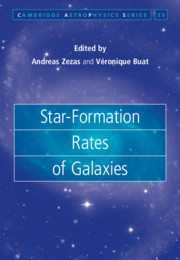Book contents
- Frontmatter
- Contents
- List of Figures
- List of Tables
- List of Contributors
- Preface
- Part I Background
- Part II SFR Measurements
- 5 Star-Formation Rates from Resolved Stellar Populations
- 6 Star-Formation Measurements in Nearby Galaxies
- 7 Continuum and Emission-Line Star-Formation Rate Indicators
- 8 Star-Formation Rates from Spectral Energy Distributions of Galaxies
- 9 Modelling the Spectral Energy Distribution of Star-Forming Galaxies with Radiative Transfer Methods
- 10 Measuring the Star-Formation Rate in Active Galactic Nuclei
- 11 High-Energy Star-Formation Rate Indicators
- Index
5 - Star-Formation Rates from Resolved Stellar Populations
from Part II - SFR Measurements
Published online by Cambridge University Press: 11 May 2021
- Frontmatter
- Contents
- List of Figures
- List of Tables
- List of Contributors
- Preface
- Part I Background
- Part II SFR Measurements
- 5 Star-Formation Rates from Resolved Stellar Populations
- 6 Star-Formation Measurements in Nearby Galaxies
- 7 Continuum and Emission-Line Star-Formation Rate Indicators
- 8 Star-Formation Rates from Spectral Energy Distributions of Galaxies
- 9 Modelling the Spectral Energy Distribution of Star-Forming Galaxies with Radiative Transfer Methods
- 10 Measuring the Star-Formation Rate in Active Galactic Nuclei
- 11 High-Energy Star-Formation Rate Indicators
- Index
Summary
In many ways the study of resolved stellar populations is the bestmethod for exploring properties of stellar populations. However, the method requires measurements to be obtained for individual stars, and this rapidly becomes challenging as the distance to extragalactic systems increases. The depths of resolved stellar samples in galaxies are primarily limited by the levels of stellarfluxes and effects of crowding. Currently most resolved stellar population studies are constrained to galaxies within a distance of about 20 Mpc. Fortunately, the short-lived massive stars, whose numbers trace SFRs, are luminous and thus among the most readily observed, especially when they are not obscured by interstellar dust. The number of stars above a fiducial luminosity in a set of spectroscopic band-passesare counted and corrected for incomplete sampling. The distribution of these stars is then compared to expectations of stellar population models to derive estimates for the observed mass in the form of stars detected in the data. Further modeling provides an interpretation in terms of stellar masses within age bins. In this chapter we provide a brief overview of the history and some of the techniques used to derive star-formation rates (SFRs) and the associated star-formation histories of galaxies through observations
Keywords
- Type
- Chapter
- Information
- Star-Formation Rates of Galaxies , pp. 115 - 144Publisher: Cambridge University PressPrint publication year: 2021

